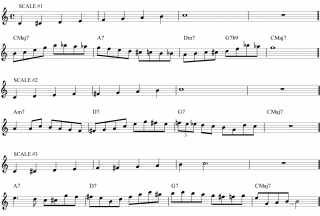Thursday evening, April 12, I left Grand Rapids to go chase storms out west. It was a great time and a successful chase, but on the way home Sunday night I began to cough, and the cough blossomed into the worst case of bronchitis I’ve ever had. For two weeks, I languished. My activity was limited to coughing, and coughing, and coughing some more; prostrating myself before the vaporizer for extended inhalation sessions punctuated by periodic steamy showers; slurping down massive quantities of fluids; and sleeping like I never planned to wake up and didn’t want to (which, indeed, I didn’t).
Over the past three days, I’ve finally begun to feel human again. Today I woke up feeling pretty good, with just a remnant of a cough and my voice returning to some semblance of its normal self. What a relief!
Naturally, I was pining to get at my saxophone. Three weeks away from it is way too long. I’d been in top form when I left for Oklahoma and Kansas, and now I’ve got some ground to recover.
So this evening I grabbed my horn and headed to my beloved railroad tracks, where it’s my wont to park my car, work over my horn, and wait for the trains to roll by. Out by a crossing near the rural community of Alto, I assembled my beautiful Conn 6M Ladyface and began to blow the rust out of my fingers and the cobwebs out of my head.
It felt so good!
There is something about reuniting with my saxophone after an extended period away from it that feels at once awkward, restorative, frustrating, cathartic, and encouraging. The awkwardness and frustration come from having spent enough time not playing my instrument that it feels a bit foreign to my hands, not quite the comfortable extension of me that it normally is. My technique isn’t as smooth, and material I had recently been practicing has to be called back to memory. The encouragement arises with the discovery that, hey, I don’t sound all that bad, regardless. In fact, I sound pretty good. Something about the time away seems to tap into reservoirs of creativity I didn’t realize existed, and if my playing isn’t quite as facile as I’d like, there’s nevertheless a compensatory freshness to it. My fingers don’t fall as readily into the same glib patterns, and so instead they find their way toward new ideas.
As for the restorative and cathartic aspects of picking up my saxophone after a lengthy period of illness, do I really need to explain? It’s just such a marvelous feeling to play again, to experience the physicality of making music: the balanced resistance and give of the reed in conjunction with my airstream, the feel of the keys beneath my fingers as I practice patterns and craft spontaneous melody lines. There’s nothing like it.
With the arrival of spring weather, I’ve been pretty consumed with storm chasing. The chase season is here for a limited time, and one must make the most of it while the opportunity is there. But the musical part of me doesn’t at all go dormant during storm season. I prioritize chasing over musical engagements, but not over the music itself. I continue to practice and push myself as a saxophonist, even if the bulk of my blog posts during this season focus on severe weather.
Tonight I’m taking a hiatus from the weather to reflect on this other part of myself, the musical part. How good it feels to play! Thank you, Lord, for the gift of music–for this amazing instrument you’ve placed in my hands, and for the passion and the drive to continue striving for the mastery of it. It is such a joy to play my horn once again!


